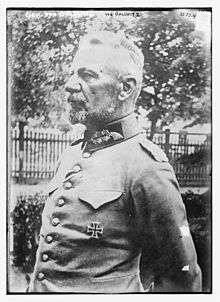Max von Gallwitz
| Max von Gallwitz | |
|---|---|
 Gallwitz in 1915 | |
| Born |
May 2, 1852 Breslau, Province of Silesia, Kingdom of Prussia now Wrocław, Lower Silesian Voivodeship, Poland |
| Died |
April 18, 1937 (aged 84) Naples, Campania, Kingdom of Italy |
| Allegiance |
|
| Service/branch | Army |
| Years of service | 1870-1918 |
| Rank | General |
| Commands held |
Guards Reserve Corps Twelfth Army Eleventh Army Second Army Fifth Army Army Group Gallwitz |
| Battles/wars | World War I |
Max Karl Wilhelm von Gallwitz (2 May 1852 – 18 April 1937) was a German general from Breslau (Wrocław), Silesia, who served with distinction during World War I on both the Eastern and Western Fronts.[1][2]
Biography

Gallwitz grew up in a Catholic family in Breslau. In 1891, he married Friedrike (*1871). They had a daughter and son Werner, who became a Lieutenant general in the Second World War. Later, he began the First World War as a corps commander (Guards Reserve Corps) on the Western Front, but was almost immediately transferred east to join the Eighth Army under Hindenburg.[1] In 1915 he took command of Armee-Gruppe Gallwitz[3] (later redesignated Twelfth Army) and participated in the Galicia offensive alongside Mackensen, who commanded the Eleventh Army.[4]
Towards the end of 1915, he succeeded Mackensen as commander of the Eleventh Army, as the latter campaigned against Serbia. In 1916, Gallwitz moved back to the Western Front and defended against the British attack in the Battle of the Somme. He took over command of 2nd Army and of Heeresgruppe Gallwitz - Somme[5] controlling 1st and 2nd Armies. From 1916-18 he commanded the Fifth Army in the west, most notably engaging the Americans during the Battle of Saint-Mihiel.
Following his retirement from the army, Gallwitz served as a deputy in the Reichstag (1920–24) for the German National People's Party.[4]
Awards and decorations
- Pour le Mérite (24 July 1915), Oak Leaves added on 28 September 1915
- Grand Cross of the Order of the Red Eagle
- Order of the Black Eagle (23 December 1917)
References
- Notes
- 1 2 Duffy, Michael (2009-08-22), Who's Who - Max von Gallwitz, firstworldwar.com
- ↑ Duffy, Michael (2009-08-22), Primary Documents - Max von Gallwitz on the Battle of St Mihiel, 12 September 1918, firstworldwar.com
- ↑ Armee-Gruppe or Army Group in the sense of a group within an Army and under its command, generally formed as a temporary measure for a specific task.
- 1 2 Rickard, J. (2007-10-03), Max von Gallwitz, German General, 1852-1937
- ↑ Heeresgruppe or Army Group in the sense of a number of armies under a single commander.
- Bibliography (biography)
- Jung, Jakob (1995). Max von Gallwitz (1852-1937) (in German). Biblio. p. 292. ISBN 978-3-7648-2435-8.
| Military offices | ||
|---|---|---|
| Preceded by New Formation |
Commander, Guards Reserve Corps 2 August 1914–9 February 1915 |
Succeeded by Upgraded to Armee-Gruppe Gallwitz |
| Preceded by Upgraded from Guards Reserve Corps |
Commander, Armee-Gruppe Gallwitz 9 February 1915–7 August 1915 |
Succeeded by Upgraded to 12th Army |
| Preceded by Upgraded from Armee-Gruppe Gallwitz |
Commander, 12th Army 7 August 1915–22 September 1915 |
Succeeded by General der Infanterie Max von Fabeck |
| Preceded by Generalfeldmarschall August von Mackensen |
Commander, 11th Army 23 September 1915-16 April 1916 |
Succeeded by General der Infanterie Arnold von Winckler |
| Preceded by General der Infanterie Fritz von Below |
Commander, 2nd Army 19 July 1916–17 December 1916 |
Succeeded by General der Kavallerie Georg von der Marwitz |
| Preceded by General der Infanterie Ewald von Lochow |
Commander, 5th Army 17 December 1916–27 September 1918 |
Succeeded by General der Kavallerie Georg von der Marwitz |
| Preceded by New creation |
Commander, Army Group Gallwitz 1 February 1918–11 November 1918 |
Succeeded by Dissolved |